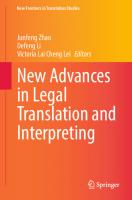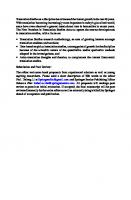New Frontiers in Japanese Studies [1 ed.]
Over the last 70 years, Japanese Studies scholarship has gone through several dominant paradigms, from ‘demystifying the
302 96 2MB
English Year 2020
Table of contents :
Cover
Half Title
Series Page
Title Page
Copyright Page
Dedication
Table of Contents
List of Figures
List of Tables
List of Contributors
Notes on the text
Acknowledgments
Introduction: Envisioning new frontiers in Japanese Studies
The history of Japanese Studies
Going beyond methodological nationalism
Structure of the book
References
Part I: Rethinking Japanese area studies in the twenty-first century
Chapter 1: Rethinking the Maria Luz Incident: Methodological cosmopolitanism and Meiji Japan
Convergence: Japan in the world
Transnational Japan
Conclusion
Notes
References
Chapter 2: Exporting theory ‘made in Japan’: The case of contents tourism
Japanese universities in the neoliberal/rankings era
Contents tourism
Notes
References
Chapter 3: Japanese language education and Japanese Studies as intercultural learning
The relation between Japanese language education and Japanese studies in the past
Intercultural learning
Classroom examples of intercultural learning in Japanese language teaching
Conclusion
Notes
References
Chapter 4: Japanese Studies in China and Sino-Japanese Relations, 1945–2018
Sino-Japanese relations, 1945–2018
Japanese language education in China from 1945 to 2018
Japanese Studies in China from 1945 to 2018
Conclusions
References
Chapter 5: Japanese Studies in Indonesia
Postwar Indonesia–Japan diplomatic relations
Japanese Studies in Indonesian higher education (1960s to 2010s)
Critiques of Japanese Studies
Critical thinking in Japanese Studies: Universitas Indonesia and Universitas Airlangga
Conclusions
Notes
References
Part II: Coping with an ageing society
Chapter 6: Discover tomorrow: Tokyo’s ‘barrier-free’ Olympic legacy and the urban ageing population
The Olympic Games and Tokyo
Japan and barrier-free
Elderly and the behind the scenes
Conclusions
Note
References
Chapter 7: Foreign care workers in ageing Japan: Filipino carers of the elderly in long-term care facilities
Elderly care in Japan
Long-term elderly care as an embodied experience
Methodology
Expanding cultural encounters of care in Japanese long-term care facilities
Conclusion
Notes
References
Chapter 8: Immigrants caring for other immigrants: The case of the Kaagapay Oita Filipino Association
Role of organisations in immigrants’ lives
Ethnographic fieldwork
Spiritual care: psychological effects of religious activities
Health care: of being carers for each other
Mourning and providing death care
Conclusion
References
Part III: Migration and mobility
Chapter 9: Invisible migrants from Sakhalin in the 1960s: A new page in Japanese migration studies
Types and periods of repatriation from Sakhalin
Individual repatriation or returning home, 1960–1991
Conclusions
References
Chapter 10: Japanese women in Korea in the postwar: Between repatriation and returning home
The node of ethnicity, class and gender
From repatriates to returnees
From the Japan Women’s Association of Korea to Fuyo-kai
Normalisation of diplomatic relations and the path to returning home
The campaigns of Japanese women in Korea
Conclusion
Note
References
Chapter 11: Challenging the ‘global’ in the global periphery: Performances and negotiations of academic and personal identities among JET-alumni Japan scholars based in Japan
The JET Programme as a symbol of ‘internationalisation’
Methods and data
The JET Programme as an entry to Japan
Being privileged and finding comfort in Japan
Negotiating marginalisation at the local level
Attempting to impact the centre in the global periphery
Area studies vs discipline
Conclusions
Acknowledgements
Notes
References
Chapter 12: Dream vs reality: The lives of Bangladeshi language students in Japan
Migration and Bangladeshis in Japan
The context of student migration in Bangladesh
Language students’ lives in Japan
Shaping the future
Conclusions
References
Chapter 13: Sending them over the seas: Japanese judges crossing legal boundaries through lived experiences in Australia
Japanese judges at the Melbourne Law School
Melbourne Law School judicial alumni: questionnaire responses
International experience: global mobility
Training for judges: lessons for other jurisdictions?
Conclusion: mobility and judicial training
Notes
References
Chapter 14: ‘Life could not be better since I left Japan!’: Transnational mobility of Japanese individuals to Europe and the post-Fordist quest for subjective well-being outside Japan
Case 1: the ‘professional unemployed’ and personal fulfilment
Case 2: ‘Wanting to leave something behind in a meaningless life’
Case 3: ‘I think I would have died if I had stayed in Japan’
Discussion
References
Part IV: The environment
Chapter 15: Japan’s environmental injustice paradigm and transnational activism
Environmental injustice at home
Concluding thoughts
References
Chapter 16: ‘Community power’: Renewable energy policy and production in post-Fukushima Japan
Deregulating Japan’s electricity market
Stories from Fukushima
Ways of living sustainably
References
Appendix: Survey on Japanese-language education abroad
Index
Cover
Half Title
Series Page
Title Page
Copyright Page
Dedication
Table of Contents
List of Figures
List of Tables
List of Contributors
Notes on the text
Acknowledgments
Introduction: Envisioning new frontiers in Japanese Studies
The history of Japanese Studies
Going beyond methodological nationalism
Structure of the book
References
Part I: Rethinking Japanese area studies in the twenty-first century
Chapter 1: Rethinking the Maria Luz Incident: Methodological cosmopolitanism and Meiji Japan
Convergence: Japan in the world
Transnational Japan
Conclusion
Notes
References
Chapter 2: Exporting theory ‘made in Japan’: The case of contents tourism
Japanese universities in the neoliberal/rankings era
Contents tourism
Notes
References
Chapter 3: Japanese language education and Japanese Studies as intercultural learning
The relation between Japanese language education and Japanese studies in the past
Intercultural learning
Classroom examples of intercultural learning in Japanese language teaching
Conclusion
Notes
References
Chapter 4: Japanese Studies in China and Sino-Japanese Relations, 1945–2018
Sino-Japanese relations, 1945–2018
Japanese language education in China from 1945 to 2018
Japanese Studies in China from 1945 to 2018
Conclusions
References
Chapter 5: Japanese Studies in Indonesia
Postwar Indonesia–Japan diplomatic relations
Japanese Studies in Indonesian higher education (1960s to 2010s)
Critiques of Japanese Studies
Critical thinking in Japanese Studies: Universitas Indonesia and Universitas Airlangga
Conclusions
Notes
References
Part II: Coping with an ageing society
Chapter 6: Discover tomorrow: Tokyo’s ‘barrier-free’ Olympic legacy and the urban ageing population
The Olympic Games and Tokyo
Japan and barrier-free
Elderly and the behind the scenes
Conclusions
Note
References
Chapter 7: Foreign care workers in ageing Japan: Filipino carers of the elderly in long-term care facilities
Elderly care in Japan
Long-term elderly care as an embodied experience
Methodology
Expanding cultural encounters of care in Japanese long-term care facilities
Conclusion
Notes
References
Chapter 8: Immigrants caring for other immigrants: The case of the Kaagapay Oita Filipino Association
Role of organisations in immigrants’ lives
Ethnographic fieldwork
Spiritual care: psychological effects of religious activities
Health care: of being carers for each other
Mourning and providing death care
Conclusion
References
Part III: Migration and mobility
Chapter 9: Invisible migrants from Sakhalin in the 1960s: A new page in Japanese migration studies
Types and periods of repatriation from Sakhalin
Individual repatriation or returning home, 1960–1991
Conclusions
References
Chapter 10: Japanese women in Korea in the postwar: Between repatriation and returning home
The node of ethnicity, class and gender
From repatriates to returnees
From the Japan Women’s Association of Korea to Fuyo-kai
Normalisation of diplomatic relations and the path to returning home
The campaigns of Japanese women in Korea
Conclusion
Note
References
Chapter 11: Challenging the ‘global’ in the global periphery: Performances and negotiations of academic and personal identities among JET-alumni Japan scholars based in Japan
The JET Programme as a symbol of ‘internationalisation’
Methods and data
The JET Programme as an entry to Japan
Being privileged and finding comfort in Japan
Negotiating marginalisation at the local level
Attempting to impact the centre in the global periphery
Area studies vs discipline
Conclusions
Acknowledgements
Notes
References
Chapter 12: Dream vs reality: The lives of Bangladeshi language students in Japan
Migration and Bangladeshis in Japan
The context of student migration in Bangladesh
Language students’ lives in Japan
Shaping the future
Conclusions
References
Chapter 13: Sending them over the seas: Japanese judges crossing legal boundaries through lived experiences in Australia
Japanese judges at the Melbourne Law School
Melbourne Law School judicial alumni: questionnaire responses
International experience: global mobility
Training for judges: lessons for other jurisdictions?
Conclusion: mobility and judicial training
Notes
References
Chapter 14: ‘Life could not be better since I left Japan!’: Transnational mobility of Japanese individuals to Europe and the post-Fordist quest for subjective well-being outside Japan
Case 1: the ‘professional unemployed’ and personal fulfilment
Case 2: ‘Wanting to leave something behind in a meaningless life’
Case 3: ‘I think I would have died if I had stayed in Japan’
Discussion
References
Part IV: The environment
Chapter 15: Japan’s environmental injustice paradigm and transnational activism
Environmental injustice at home
Concluding thoughts
References
Chapter 16: ‘Community power’: Renewable energy policy and production in post-Fukushima Japan
Deregulating Japan’s electricity market
Stories from Fukushima
Ways of living sustainably
References
Appendix: Survey on Japanese-language education abroad
Index
![New Frontiers in Japanese Studies [1 ed.]](https://ebin.pub/img/200x200/new-frontiers-in-japanese-studies-1nbsped.jpg)
- Author / Uploaded
- Akihiro Ogawa (editor)
- Philip Seaton (editor)
![New Frontiers in Japanese Studies [1 ed.]
9780367406806, 9780367821494](https://ebin.pub/img/200x200/new-frontiers-in-japanese-studies-1nbsped-9780367406806-9780367821494.jpg)








